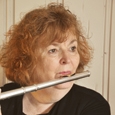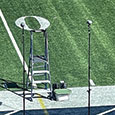When I judge a competition or evaluate a student’s presentation in a lesson, the first thing I hear is the sound. Flutists should think of the sound as a gift to listeners. As with any gift, we want it to be the best of ourselves. When selecting a sound, a performer creates an appropriate sound for the music basing ideas upon the composer, style period, emotional content of the music, tempo, printed dynamic, range in which this note falls on the flute, intonation, note-length, and probably above all on what the flutist considers to be a beautiful sound on the instrument. The challenge as teachers is to help students find their way so they can make artistic choices.
Producing a beautiful sound begins with a concept of what the flute sounds like in a variety of circumstances. While students learn by listening to CDs and live performances, their single most important influence is their teacher. For this reason, I play with beginning level students through most of their lessons. Playing the flute takes lots of air. Using so much air so quickly is tiring. Having someone playing along encourages students to continue playing and not stop when they get tired. I also use vibrato while playing with beginning students. It never fails that students begin to imitate my vibrato around lesson number nine. As soon as I hear any quiver in the sound, I explain how vibrato is produced and start them on vibrato exercises. I suggest reviewing beginning pages of a method book using counted or measured vibrato.
I continue to play some parts of a lesson in unison with students throughout their study with me. Usually I play the warm-up exercises with them because I want them to know that I value playing the same exercises day after day in my own practice. Sometimes in etudes we alternate playing etudes in a Ping-Pong style: I play one chunk and the student plays the next. This exercise trains the eye so students see note-grouping patterns and melodic patterns rather than just a string of seemingly unrelated notes.
Sometimes I play portions of a solo piece or chamber work so students can hear what a professional tone sounds like close up in a particular passage. Students are always confused about the difference of dynamic between a tutti piano and a solo piano. A solo piano is much louder because the flutist must project the solo to the back of the hall. In a tutti piano the dynamic is much less because the flutist functions as an accompaniment rather than as a soloist. Periodically we have duet lessons so I can work on chamber music performance skills such as breathing together, eye contact, and using the end of the flute for cueing. However, these skills can also be effectively taught in flute choir rehearsals.
Alignment of the Flute
Teach students to align the flute the same way each time they play. This means that muscles are used the same way while playing. However, if one day the flute is rolled out and the next day rolled in, there is no consistency in how the muscles are used. I prefer the classic line-up in which an imaginary line is drawn from the center of the right hand keys (D, E, F) through the center of the embouchure hole. If the headjoint is positioned like this then the embouchure hole is level with the floor and facing the ceiling. This is the optimum position for the headjoint to achieve supreme projection of sound into the audience. It also will allow the flutist to play more naturally in tune.
To align a student’s flute, pulling the headjoint out from the body about ¼ of an inch. Use a ruler to check this measurement. Using a felt-tipped marker, mark four to eight lines around both the headjoint and body of the flute. In the past I only marked the headjoint in one place, but have learned if I place more marks, they all do not rub off on the same day. I check the marks at each lesson replacing them when necessary. Eventually students will be able to align the instrument correctly without marks; however, I sometimes mark my own flutes, especially low flutes with curved headjoints.
When a flute is aligned correctly, I can check from across the room how much lip a student is using to cover the embouchure hole by the placement of where the keys of the flute align with the floor. Keys should be level and parallel to the floor and of course always facing the ceiling. If a flute is rolled back toward the flutist, this means the student does not have the flute balanced well on the ridge just above the left knuckle but is balancing the flute with the left hand thumb.
Alignment of the Body
Each day as I read my Facebook feed I see many pictures of flutists. Just from these pictures, I can tell if a flutist is getting an optimum sound out of the instrument. If the embouchure hole is rolled back toward the player, the sound will be small, lacking in ring, and the intonation will be poor. While it is easier to jump octaves with the embouchure hole rolled in, it is better to keep the embouchure hole level and develop the embouchure muscles. Slurring the harmonic series up and down, using the fundaments notes of C4, C#4, D4, several times in each practice session will prove beneficial. Practicing a diminuendo or taper on high notes regularly will add increased control to the embouchure.
The most common mistake I observe in pictures is the angle of the flute in relationship to the flutist. The flute should not be played parallel to the shoulders as in a marching band but should be played with the end of the flute positioned away from the body. The best place is with the end of the flute in front of the player’s nose. Most pictures show the placement of the end of the flute behind the flutist’s ear. To correct this, move the right shoulder forward while pushing the end of the flute to the proper place. To the player this will feel like the embouchure plate is not equally positioned in the chin, but will be more securely placed on the left side of the chin than the right. However, if the player has an aperture that is off-sided to the right, rather than to his left, this position will not work properly.
The Sound and Your Feet
The floor is the bottom of the sound, and the ceiling is the top of the sound. Great flutists know how to use the practice room or concert hall to their benefit. Most teachers have said, “Fill the space with your sound.” However, before players can do that, the body must be grounded.
In a good seated position a player can stand up without moving or adjusting the feet. However, when standing, many flutists do not think about where their feet are positioned. The sound and the musical line are better when flutists are in control of their foot placement.
Look at YouTube videos of favorite flutists. Notice the placement of their feet. Most really good flutists play with the left foot forward and the right foot back. Even those who say in masterclasses that the feet should be side by side, often move to the left foot forward and right foot back position when they perform because this provides the most strength. This stance is found in many sports such as fencing or serving a volley ball. Try this position and notice how the feet and legs become a partner in producing your sound. Many flutists slowly shift their weight from their back right foot to their left front foot when playing. This slight shifting of body weight keeps the knees unlocked and free.
Hang the Arms
When playing, elbows should point to the floor. Let the arms hang naturally to reduce the tension in the upper torso. The position with elbows up and out that is used in marching band drills has little to do with healthy, artistic playing.
Hang the Jaw
Flutists who have a large, full sound let the jaw hang so there is more room in the mouth. Think of not opening the mouth in the front but opening equally between the front and back teeth. Once the jaw is hanging, use the tongue in a variety of placements to change the angle of the air as it hits the wall of the embouchure hole to develop more tone colors. To explore these placements, play notes with the tongue in the long and short vowel placements (a, e, i, o, u).
Get a Mirror
Check to be sure that the aperture and embouchure hole are aligned. Students with shorts arms will naturally want to bring their arms closer to their bodies which places the flute too far to the left of the aperture. Check to be sure that the embou-chure plate is parallel with the lips. It used to be more in vogue to have the flute dropped to the right which meant that the embouchure plate became angled at the lip. Be sure when purchasing a headjoint that the headjoint’s embouchure hole is not larger than the natural aperture of the player.
The head should balance on the spine. Have the flutist nod up and down several times to find the balancing place. If the head is held too high then the air stream will not be efficiently directed to the edge of the back wall of the flute.
While looking in the mirror play scales, arpeggios, and seventh chord patterns while watching the fingers in the mirror. Fingers should be relaxed yet move with an articulated motion. Clinched, tight fingers, lead to a tight sound. Practicing trills with each finger is still an excellent way to learn to move the individual finger quickly and evenly. All fingers move from the third knuckle back from the nail except for the left index finger which moves from the second knuckle back. (See: A Picture is Worth 10,000 Words, Flute Talk, October 2011)
While playing scales watch to be sure that there is no vertical movement of the flute as you change fingerings from the right hand to the left hand. Strive for a balance so you can go up and down the range with the flute staying in the same place throughout the exercise. Sometimes I play trills alternating from F to G in the second octave to the G to A trill in the second octave watching that the end of the flute does not become higher when I play G to A and lower for the F to G trill.
The Setup
Once teachers learn to spot problems in a student’s setup, they will probably find that they apply these concepts to their own playing. An awareness of where each part of the body is and what it is doing, will help flutists make better choices. Each of which will add something positive to the sound. When you gain a little here and then a little there eventually added together, there is major improvement.






